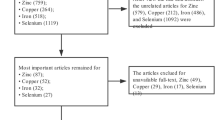Abstract
The aim of the study was to examine the influence of alcohol consumption on the severity of psoriasis and selenium (Se) concentration and Se-dependent gluathione peroxidase activity in plasma (pl-GSH-Px) and in erythrocytes (RBC-GSH-Px) in psoriatic patients. Thirty-five in-patients with psoriasis lasting <10 mo and 42 with psoriasis lasting >3 yr constituted groups 1 and 2, respectively. The severity of psoriasis was assessed using the PASI scoring system and the consumption of alcohol, using a structured questionnaire. The Se concentration was 47.11±11.61 µg/L in group 1 and 38.69±13.22 µg/L in group 2 (p<0.05), the pl-GSH-Px was 0.15±0.04 U/mL and 0.14±0.04 U/mL (p>0.05), and the RBC-GSH-Px was 13.97±4.27 U/g Hb and 13.16±3.85 U/g Hb (p>0.05), respectively. In excessive drinkers (<10% of patients, all males), the Se concentration was 32.84±10.88 µg/L, the pl-GSH-Px was 0.15±0.03 U/mL, and the RBC-GSH-Px was 11.64±3.32 U/g Hb. A low RBC-GSH-Px correlated to the consumption of high-grade alcoholic beverages (R=−0.45, p<0.05) and to the PASI value (R=−0.37, p<0.05) in group 2. Depressed Se concentration and Se-dependent GSH-Px can be related to the severity and a duration of psoriasis. The excessive consumption of alcohol is associated with severity of the disease and with low activity of GSH-Px in erythrocytes in patients with long-lasting psoriasis.
Similar content being viewed by others
References
J.-P. Ortonne, Recent developments in the understanding of the pathogenesis of psoriasis, Br. J. Dermatol. 140 (Suppl. 54), 1–7 (1999).
L. R. Braathen, G. Botten, and T. Bjerkedal, Psoriatics in Norway. A questionnaire study on health status, contact with paramedical professions, and alcohol and tobacco consumption. Acta Derm. Venereol. 142 (Suppl.), 9–12 (1989).
K. Poikolainen, T. Reunala, J. Karvonen, J. Lauhranta, and P. Karkkainen, Alcohol intake: a risk for psoriasis in young and middle aged men? Br. Med. J. 300, 780–783 (1990).
L. Naldi, F. Parazzini, and A. Brevi, Family history, smoking habits, alcohol consumption and the risk of psoriasis, Br. J. Dermatol. 127, 212–217 (1992).
L. Naldi, L. Peli, F. Parazzini, and the Psoriasis Study Group of the Italian Group for Epidemiological Research in Dermatology, Association of early-stage psoriasis with smoking and male alcohol consumption, Arch. Dermatol. 135, 1479–1484 (1999).
B. E. Monk and S. M. Neil, Alcohol consumption and psoriasis, Dermatologica 173, 57–60 (1986).
M. A. Gupta, N. Schork, A. K. Gupta, and L. N. Ellis, Alcohol intake and treatment responsiveness of psoriasis: a prospective study, J. Am. Acad. Dermatol. 28, 730–732 (1993).
C. S. Lieber, Medical disorders of alcoholism, N. Engl. J. Med. 333, 1058–1065 (1995).
B. A. Zadorozhny, E. V. Adolf, and V. P. Shevchenko, Free radicals in the skin of patients with psoriasis and their relationship to oxidative-reductive processes. Vestn. Dermatol. Venereol. 47, 25–28 (1973).
M. Roy, L. Kiremidjan-Schumacher, H. I. Wishe, M. W. Cohen, and G. Stotzky, Effect of selenium on the expression of high affinity interleukin 2 receptors, Proc. Soc. Exp. Biol. Med. 200, 36–43 (1992).
P. Celerier, A. Richard, P. Litoux, and B. Dreno, Modulatory effects of selenium and strontium salts on keratinocyte-derived inflammatory cytokines. Arch. Dermatol. Res. 287, 680–682 (1995).
J. E. Spallholtz, L. M. Boylan, and H. S. Larsen, Advances in understanding selenium role in the immune system, Ann. NY Acad. Sci. 587, 123–139 (1990).
J. E. Spallholz, On the nature of selenium toxicity and carcinostatic activity, Free Radical Biol. Med. 17, 45–64 (1993).
R. C. McKenzie, Selenium, ultraviolet radiation and the skin, Clin. Exp. Dermatol. 25, 631–636 (2000).
M. S. Stewart, J. E. Spallholz, K. H. Neldner, and B. C. Pence, Selenium compounds have disparate abilities to impose oxidative stress and induce apoptosis, Free Radical Biol. Med. 26, 42–48 (1999).
T. Zima, L. Fialova, O. Mestek, et al., Oxidative stress, metabolism of ethanol and alcohol-related disesases, J. Biomed. Sci. 8, 59–70 (2001).
R. J. Ward and T. J. Peters, The antioxidant status of patients with either alcohol-induced liver damage or myopathy, Alcohol Alcohol. 27, 359–365 (1992).
R. J. Harvima, H. Jägerroos, E. O. Kajander, et al., Screening of effects of selenomethionine-enriched yeast supplementation on various immunological and chemical parameters of skin and blood in psoriatic patients, Acta Derm. Venerol. (Stockh.) 73, 88–91 (1993).
G. M. Fairris, B. Lloyd, L. Hinks, P. J. Perkins, and B. Clayton, The effect of supplementation with selenium and vitamin E in psoriasis, Ann. Clin. Biochem. 26, 83–88 (1989).
G. Michaëlsson, B. Berne, B. Carlmark, and A. Strand, Selenium in whole blood and plasma is decreased in patients with moderate and severe psoriasis, Acta Derm. Venereol. (Stockh.) 69, 29–34 (1989).
J. Pinton, H. Friden, N. Kettaneh-Wold, et al., Clinical and biological effects of balneotherapy with selenium-rich spa water in patients with psoriasis vulagaris, Br. J. Dermatol. 133, 344–346 (1995).
T. Fredriksson and V. Petersson, Sever psoriasis: oral therapy with a new retinoid, Dermatologica 157, 238–244 (1978).
W. Wąsowicz and B. A. Zachara, Selenium concentration in the blood and urine of a healthy Polish sub-population, J. Clin. Chem. Clin. Biochem. 25, 409–412 (1987).
D. E. Paglia and W. N. Valentine, Studies on quantitative and qualitative characterisation of erythrocyte gluatathione peroxidase, J. Lab. Clin. Med. 70, 158–169 (1967).
J. Hopkins and G. R. Tudhope, Glutathione peroxidase in human red cells in health and disease, Br. J. Haematol. 25, 563–575 (1973).
I. H. Ginsburg and B. G. Link, Psychosocial consequences of rejection and stigma feeling in psoriasis patients, Dermatology 32, 587–591 (1993).
E. Lecomte, Herbeth B., P. Pirollet, et al., Effect of alcohol consumption on blood antioxidant nutrients and oxidative stress indicators, Am. J. Clin. Nutr. 60, 255–261 (1994).
Author information
Authors and Affiliations
Rights and permissions
About this article
Cite this article
Serwin, A.B., Waşowicz, W., Gromadzińska, J. et al. Selenium status in psoriasis and its relationship with alcohol consumption. Biol Trace Elem Res 89, 127–137 (2002). https://doi.org/10.1385/BTER:89:2:127
Received:
Accepted:
Issue Date:
DOI: https://doi.org/10.1385/BTER:89:2:127




